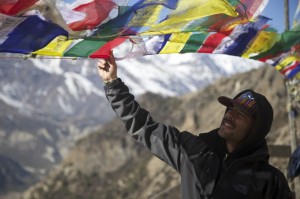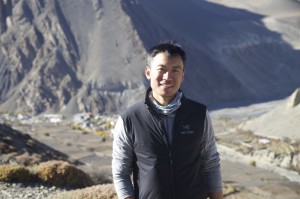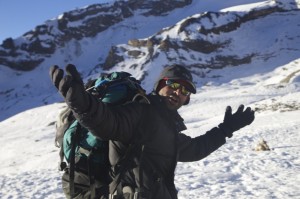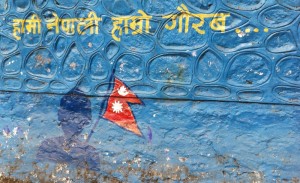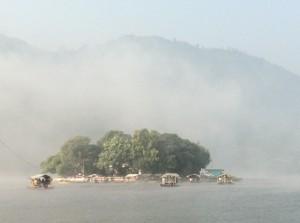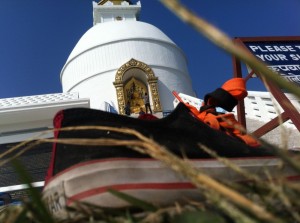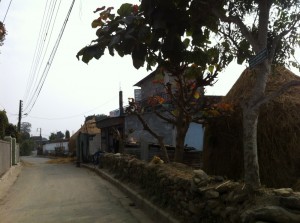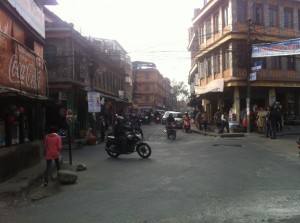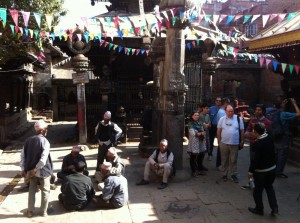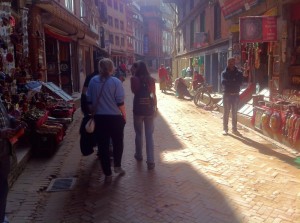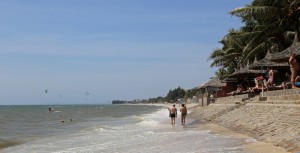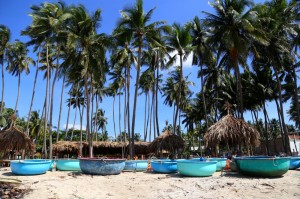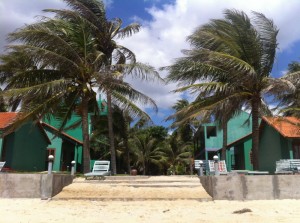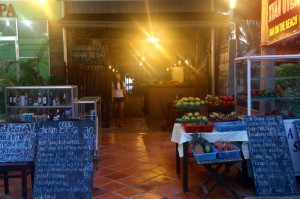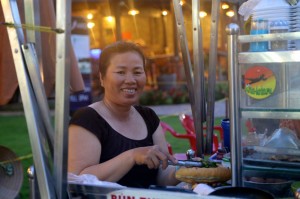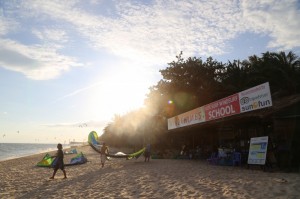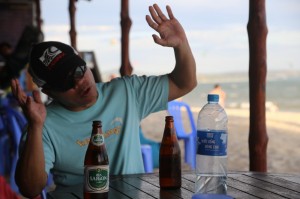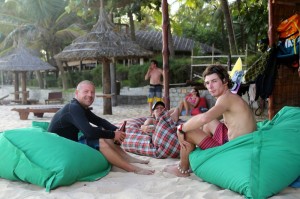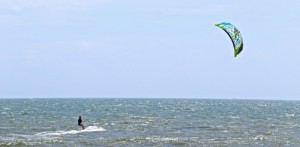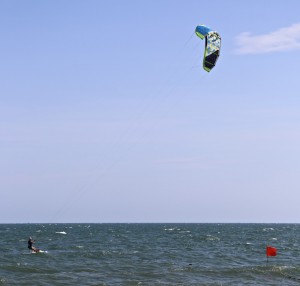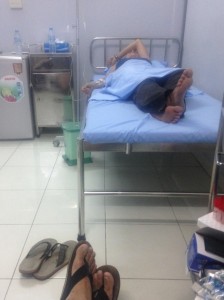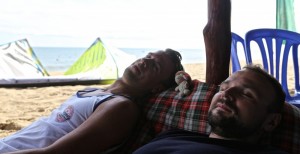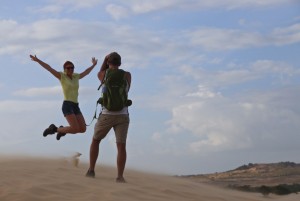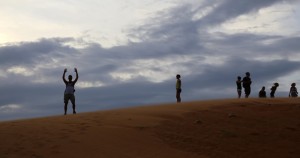At this point I have to introduce you to some people that made this trip an unforgettable one.
Carlos from Barcelona already chatted away the time with me on the way to Bhulbhule. Favorite cite: „I wont say no (preferable to everything eatable).“
Pablo, Carlos cousin warmed the heart of every trekker, local and animal in his open way. Favorite cite: „hey, hellooo.“
Wing, the ever cheerful but slightly paranoid (trekking wise) Chinese-American from NewYork. Favorite cite: „I brought a second one (of everything that a trekker would bring once).“
Yan, Wings Nepalese porter-guide who toke us in his helpful friendly arms, though he not always agreed on our decisions (probably because he had to carry all the second items). Favorite cite: „jala jala (let’s go in Nepalese)“
Juan, the ever stoned Puerto Rican, who hooked up with the group, but never really integrated. Favorite cite: „I paid the bill (turning out to be a straight lie).“ I didn’t even found a proper picture of him.
1. Day: Kathmandu-Bhulbhule
Life starts early in Nepal and so did our journey to one of the most classical trekking routes in Nepal. The bus packed with bikes for kids, Trekkers and their backpacks, a driver and his two wingman left the bus station sharp 6:45 and headed for the road to Besisahar. The road has the average wide of a truck and winds at an impressive height along the steep valley. Pretty fast we learned that one knock from the wingman means „stop something is going to hit us“ while two knocks indicated a clear way. Unfortunately the bus was scaled to the average nepalian who hardly exceeds 1.60 cm and my knees ached already after the first hour. Our journey paused regularly every 1.5 h for food or to collect other passengers. 8h later (that were shortened by what should become everyday chats with Pablo and Carlos) we stiffly arrived in Bhulbhule a tiny village at the beginning of the Annapurna circuit. The suspension bridge leading to the destination of the day the first of many tea houses looked kind of fragile but supported the eight Trekkers easily. When Tom saw the bed room in the tea house he was let’s put it a little chocked. It was just a little more than a hut with big gaps in the wall and window. But what to expect for 2€?
2. Day: Bhulbhule – Jagat
So this was the day when we finally headed for the big mountains. We had a really big breakfast (not expecting big portions I ordered two different things and Tom a set) and with round bellies we started hiking up the first hill. We didn’t expected much from the first part since the whole hiking community is fussing about the new road (which is not more than a dusty bumpy path) substituting the old trek. However, alternative routes were marked a few years ago and we walked through the scenery of lovely villages hanging on to the steep and high mountains surrounded by yellow rice paddies, where the hard working Nepalese harvested rice.
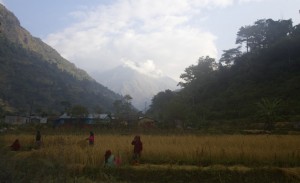
You see a lot of women doing the hard work on the fields.
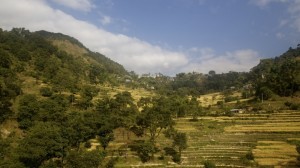
The tiny villages are found somewhere between the banana trees and yellow rice fields.
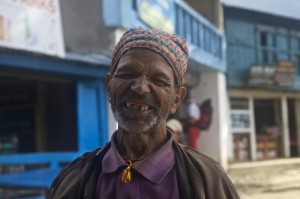
And you meet so many friendly locals. Not to mention that he made me take this picture to ask money from me afterwards.
In Jagat many tea house wanted to accommodate us (the road has definitely the drawback of many Trekkers skipping the first days so people lack guests). We found a little green one with a nice owner, hot shower Wifi and no gaps in the wall :). During this evening we good the first taste of what our daily life in lodges was going to be like, with our spanish friends that by chance ended up in the same lodge as we, the talkative american Wing and his always friendly porter-guide Yan time was flying by and food was shared across plates.
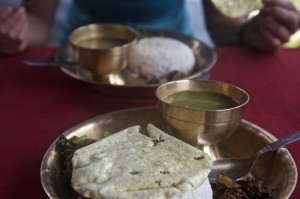
Our first of many Dhal bhaats. You get rice, lentil soup to be poured over the rice, some vegetable curry (delicious) and something fermented (mostly weird, but surely good for the vitamins).
3. Day: Jagat – Dharapani
Sleeping in Nepalese villages brings you very close to the local life. Actually that close that you are woken by a rooster 4:45 long before sun rises.
The scene changed this day from the golden rice paddies to rough and nearly rectangular mountains rising up next to the milkily wild flowing Marsyangdi. The mountain walls were most of the time so close to the river that road and path needed to be carved into them. Villages were almost falling of the high cliffs but therefore providing tea houses with a beautiful view. With increasing altitude temperatures started to decrease so I tested my new down jacket for the first time during lunch (very cosy and warm).
At the end of the day we met as if it was meant to our friends from the previous days Carlos, Pablo, Wing and Yan, so the evening got a cozy familiar atmosphere.
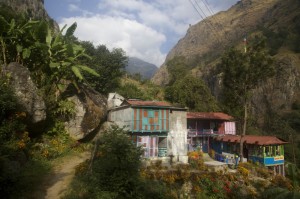
A typical tea house. Painted in all colours over looking the valley.
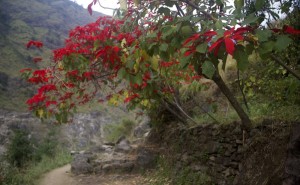
Merry Christmas everybody. Did anybody knows that poinsettias get 2m high in the natural environment?
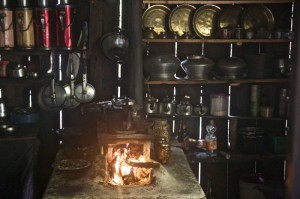
Typical tea house kitchen. Cozy but kind of smokey.
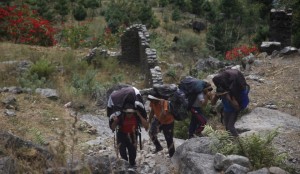
The porters carry up to 30kg up the mountains. I was absolutely used to capacity with my 10kg.
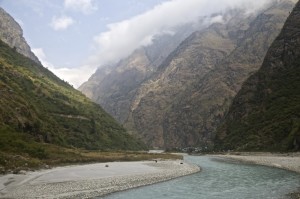
Tal is a shadowy village in the valley. Might have contributed to the cold during lunch.
4. Day: Dharapani – Chame
Somehow Yan was pushing everybody to get up early and leave soon after breakfast giving an idea what was waiting for us. For a change we decided to head off al together. So the beautiful view at the snow topped mountains on this sunny day was spiced by chatting with related minds.
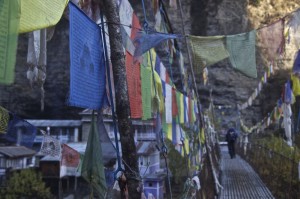
One of the many suspension bridges to come. All of them had praying cloths at one side of the bridge. Maybe to ask for save travel.
Walking through the sunbathed villages on the alternative route rewarded us with many smiles from the local people and many inquiries for sweets from the kids. The are pretty smart also asking for sweets for their increasing number siblings to get higher amounts from the Trekkers. Turning around the corner and we were walking up an down in a forest pretty close to the feeling of a European autumn forest. Many up and downs later we arrived in our comfortable lodge for to night and spent the rest of the day in front of the nicely warm oven.
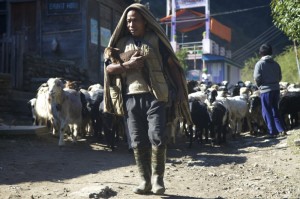
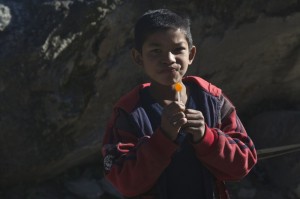
Clever guy, also asked for sweets for his sisters. We just hoped that he really handed them to them.
5. Day: Chame – Upper Pisang
Getting up this morning we were greeted by frost covering the left over cabbage in the backyard. It was the first messenger of the cold that was coming during the next days.

The nice little lodge with the perfect view on snow capped mountains and frozen cabbage (didn’t found any in my food).
The evening before we decided to take the higher route via Upper Pisang to Manang because it was supposed to be better for acclimatization. Our spanish friends were relatively easy to convince to join us, but Yan, Wings porter didn’t looked to happy about our decision. Don’t know whether he expected us to follow him or whether he just wasn’t really up for walking the more demanding road.
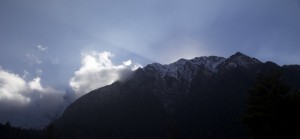
The warming sun disappears early in this valley.
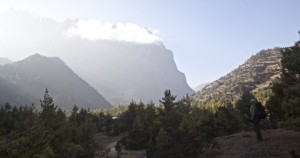
Trees are getting fewer and smaller.
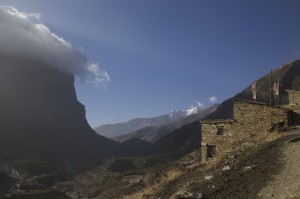
The stone houses of Upper Pisang. Most of them are empty, only the lodges still assure for life here.
The forest from the day before slowly began to lighten during the day giving space for the view on the rough mountain walls and a very chilly wind. Walking in the sun on the higher route really provided some relief. By mid afternoon we arrived in Upper Pisang a mountain village consisting of some crooked stone houses and a newly restored Buddhism temple. The monks living here were more than willing share some Buddhism history and also some personal history with us (not all of them voluntarily become monks, but we got our suspicions on whether they were any at all after we discovered that one of them was drunk).
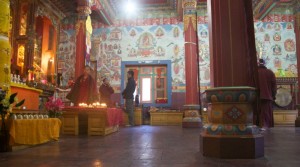
The monks were more than ambitious to share some of their knowledge with us. But I didn’t try to find out what the monk wanted to share with me, who asked whether I have a boyfriend.
By now it was so cold in the evening that everybody gathered around the fireplace in the dinning room, chatting about the track, traveling and the cold outside.
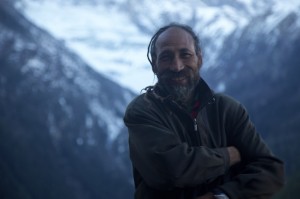
The owner of our lodge is kind of a special but really friendly guy.
6. Day: Upper Pisang – Manang
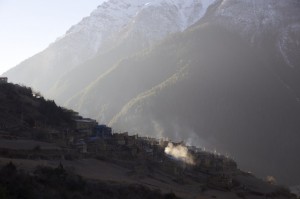
The view back to Upper Pisang in the cold morning hours.
The first night at 3300 m (an altitude I have never been before) was not as cold as expected but disturbed by hours of being awake. Getting up was hard. The becoming Australian doctor explained me that this sleep disturbance is due to the uneven breathing caused by the altitude. Diamox should treat this. Luckily not everybody is as stubborn as I am (not convinced we would need them I didn’t even bought any) and Wing offered me some of his, which I started taking right away.
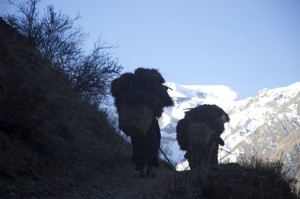
These ladies don’t get out of breath anymore, even though there are more than overloaded.
We set out on the high route to Manang and regretted it not a single second. Even though the ascent was pretty steep the view was astonishing. When we finally arrived at the top everybody was enjoying himself taking pictures in this incredible landscape.
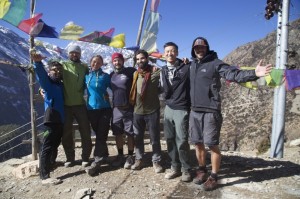
We also had some fun getting a picture taken.
Following our journey was only interrupted by some surprising delicacies. Bakeries popped up around us (probably due to the many tourists), selling cinnamon rolls, carrot cake, chocolate cake and many other things for the hungry trekker.
After a long day we arrived in Manang. Basically every Trekker stays here for two nights to acclimatise to the high altitude. For what ever reason we all expected Manang to be a smaller Kathmandu. It is naturally just a slightly bigger mountain village offering a higher number of lodges, laundry service, bakery’s and some shops sprinkled with countless Trekkers in coloured down jackets. We found an okay lodge for the night and delivered our socks to the laundry service before escaping into the warmth of the dinning room.
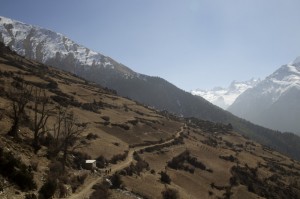
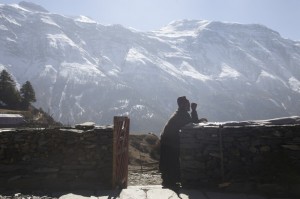
She didn’t even cared about the view a single second.
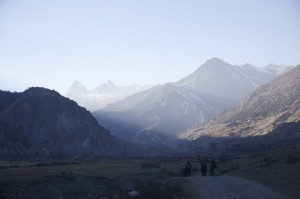
The long last meters to Manang already made us think of our assumption of little Kathmandu.
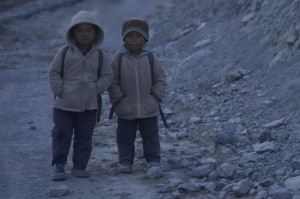
And then we met these little ghost on their way back from school.
7. Day: Manang Acclimatization
As a rule of thumb for good acclimatization you should walk high and sleep low, so we headed out for a little walk up hill passing a perfectly blue glacier lake. Arriving at 3800 m we walked along the ridge with view over the valley that lay behind us.
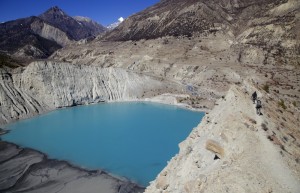
One step to the side and you would end up in the surely freezing cold glacier lake.
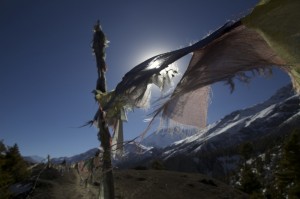
Shall I mention the view again?
A short moment of clumsiness changed the position of Pablo’s Gopro several meters downhill. You could see the panic appearing in his face. Not only was it the last picture taking possibility left after a broken camera and a broken iPhone, but it also contained pictures from the last four months of travel (of course not saved somewhere else). Carlos, Pablo and Tom went looking for it and luckily after about 20 min we heard the shout „I found it!“. The strap connected to it got caught by some tiny plants preventing it from falling down all the way to the valley.
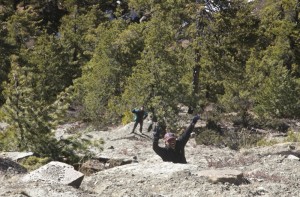
Do you see the relief in his eyes?
Back in Manang a long to do list waited for us:
1. Eating chocolate cake in one of the numerous bakeries (Tom got two pieces and me even real coffee).
2. Getting a hot shower (this solar showers are supposed to be hot during the afternoon, in reality the maybe get up to 33˚C.)
3. Eating lunch.
4. Listening to the talk about altitude sickness (It was a quite informative and entertaining talk but very cold in the room.).
5. Going to the movie theater to see „the book thief“. The movie was soso, but the little shelter in which they showed the movies in was hillarious. And tea and popcorn was included in the price.
6. Eating Yak steak for dinner. It tasted quite of animal but I guess the protein and iron is good for acclimatization.
8. Day: Manang – Churi Lathar
It was going to be a short day, but rushing to the very high altitudes is neither safe nor easy. Already the first few meters uphill with the backpack left me breathless standing and looking back to Manang.

Looking back, breathing, taking a picture.
Today we finally beat the 4000 m and everybody was hoping to be okay. We met a few people heading back, but the majority seemed to go on just well. With the decreasing temperatures flora and fauna changed. Instead of the ever present cows we met the famous source of burgers and steaks – yaks – along the way. Trees disappeared completely and the residual bushes and grass became a different shades of brown. After a sunny lunch in Jar Kahar we headed for a few more meters of altitude to Churi Lathar. The boys got a frisbee (whoever carries a frisbee up the mountains) out started playing while I decided to get my acclimatization a little kick start by climbing another 200 m.
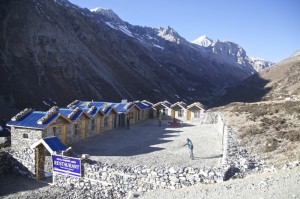
I admit, that I never saw a more appropriate place to play frisbee.
9. Day: Churi Lathar – High Camp
Getting up to climb another 630 m to high camp we decided to go for a Nepali breakfast and ordered Thukpa (in principal a hot noodle soup). Carlos showed up with a quit pale face complaining about a sleepless night with diarrhea. Everybody was already a little worried since diarrhea and altitude do not really fit well together, but some immodioum accut later he claimed to be fit enough to walk.
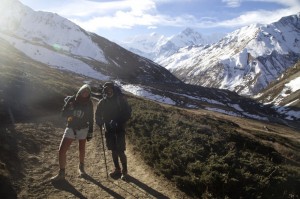
Some are suffering, but I guess a real german is warming up on an ice cube.
We climbed through the naked mountains of grey and brown color leaving the chain of ice covered peaks behind us. After 200 m uphill we saw a a tiny blue sign in front of us warning from landslides. There were quit a few spots were huge amounts of stones came down, but fortunately we didn’t see one live.
When we arrived in Thourung Pedi Carlos face showed violent signs of pain and the only thing he was doing during our lunch was leaning back and breathing deeply. Now we really got concerned. It turned out that instead of the recommended amount of two immodioum accut he took four and to be sure he took another two (six in total). His whole intestines were knotted up. After a while Yan, Wing, Tom and me decided to head on anyway, hoping that Carlos would recover enough to follow in a few hours. We regretted our decision immediately, turned around after 100 m and walked back. I guess it was one of the nicest reunions I was in and after two hours Carlos was indeed ready to head on. However due to our late leave there was only a dorm left in the high camp and we found ourselves rowed up like sardines on the upper seven beds. Anyway this had a huge advantage: it was pretty warm during the night with 9 people heating up the room.
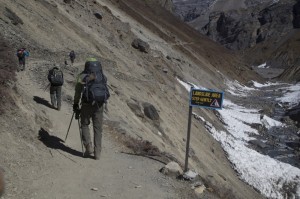
Only one trekker a time, otherwise all might be killed by the landslide and nobody is left to get help.
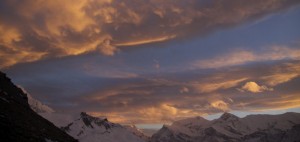
It’s fu…. cold, but the view is rewarding everything.
10. Thourung La
The destination of today was actually located several walking hours before the lodge we were staying in that night – Thourung La Pass at 5416 m. The destiny of the recent acclimatization days.
After a rather sleepless night (I never learned why you are awake in the middle of the night at high altitudes.) we got up a quarter to four to have breakfast at four and start climbing half past four in complete darkness. It seems ridiculous but somehow everybody starts that early to avoid the strong winds coming up around 10-11 am (I still think it is completely ridiculous and unnecessary). Everybody was packed in several layers of cloths in deep fear of the cold at this altitude at this time of the night. Then around 90 trekker set out on the icy path up the hill. All their headlamps make them look like glowflies collected on a chain. After a while the moon like view was perfect. Black mountains covered in ice, surrounded by stars and far away the few lights of our base station were shining up.
The climb was absolutely breathtaking, which was mostly due to the low amount of oxygen in the air. This also caused that despite the freezing temperatures I finally got warm hands and feeds.
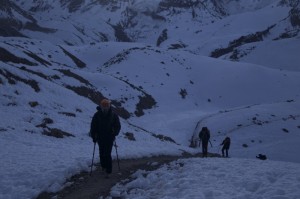
It was dark, and cold, and the cliff (that you could not see due to the darkness) was really steep.
Three hours and many up hill steps later everybody of our small group arrived at the pass in an victorious mood. Pablo described the way: when you are there all the pain is forgotten (bit like giving birth as I was told).

We made it.
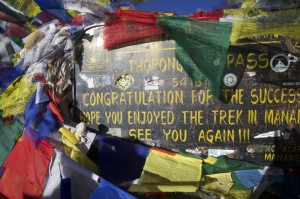
And this lazy guy let me carry him up the whole way, but he was here as well.
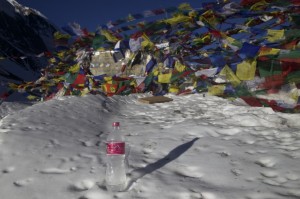
But forget about drinking, the water is frozen, when you get up here.
Of course we needed the obligatory group photo before heading down the slippery steep path in the direction of Muktinath. The ice cover made for some falls and a rather slow descend. The view essentially changed from the steep wooden cliffs into the sparse brown tibetanean plateau. It took us in total 6.5 h to get down to Muktinak. A little bit tired. Anyway it was the night to celebrate and order a few beers and Whisky.
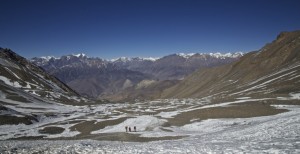
And than everything is the colour of dry sand, but much more slippery.
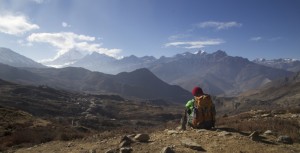
Looks so close …
However, Tom and me did not only walked up and down these days also our feelings for each other experienced some real up and downs, recently more downs. At the end of this day we decided that it was also time for a change in our relationship and that it might be better for both of us to travel on alone for a while.
11. Muktinath – Kagbeni
After the hard day of our pass conquest we couldn’t really made up our minds whether to go one, rest a day or take a jeep. In the end we compromised on making it a short day and walked to the close by Kagbeni. However getting started still took quite some time, two coffees and a tea. When we finally got ready another issue occurred. The puerto-rican Juan, who was joining our group quite frequently was accused of not having paid his bill. Since he rushed off without even saying good morning and he was a little weird anyway it didn’t seemed an unlikely action. It was not really our problem but since he was hanging out with us everybody felt betrayed and Yan got into some discussion with the owner of the lodge.
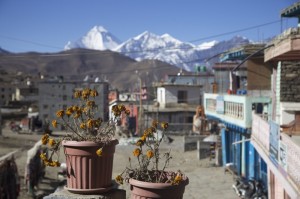
There are worse places to hang out, when you don’t know what to do.
When we finally set out the path led us through the ochre colors of a dry valley disturbed by the sharp shadows of apple trees, landslides and tiny villages. Interrupted by many shooting stops we arrived in the late afternoon in Kagbeni.
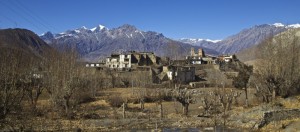
Only one of the many shoots that we took on the way.
Hardly enough time to drink a proper coffee, eat the famous apple pie and stroll through the city in search of Mr. Viagra man. When we found him it was almost to dark to take a picture, but I got a shoot anyway.
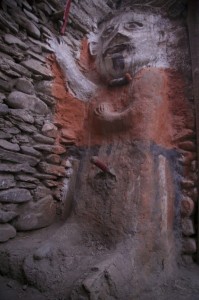
Mr. Viagra men. I don’t really want to know, what the boys did behind my back.
12. Day: Kagbeni – Marpha
Today was the most unpleasant trekking day so far. We started walking at 8am to avoid the winds that are supposed to pick up before lunch in this valley. Kagbeni and Jomson are only connected by a dusty road leading through the dry-grey river bed. Luckily there where only few jeeps and busses whirling the dust in the direction of our lungs. Unfortunately our low position in the valley also kept us from the good views.
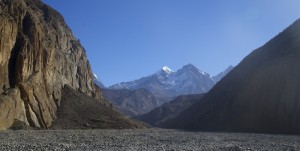
From right to left: Annapurna I, Annapurna II, Annapurna III.
Before lunch we arrived in Jomson, but since everybody was hungry we decided to find a place to eat. Somehow during our journey through Jomson Wing’s camera disappeared. So did he for a long time to look for it, but it was nowhere to be found. Of course it is not that much about the cam but about all the pictures that where taken. He took it quite well, even though all his pictures of yak steak and apple pie were gone.
This furthermore resulted in instead of heading on around 1 pm we left at 3 pm leaving not enough time for the high alternative route. So we found us again stucked with the road and the dust. On the other hand we arrived in Marpha a short hour later.
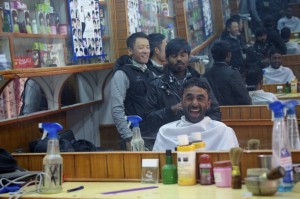
Yan decided to take the bus, so he had the time to go to the hairdresser. Maybe just for the fun of it.
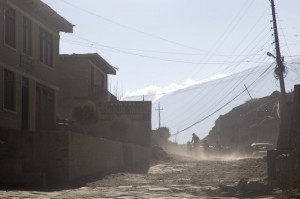
Dust is a constant companion on this side of the pass.
Marpha is a lovely clean and white painted village coming with numerous souvenir shops, chocolate craving kids, apple cake, apple brandy and european style bathrooms.
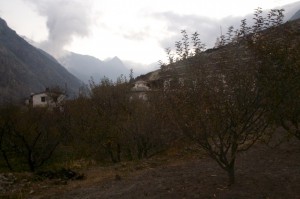
The apple trees of Marpha, being the source of the famous apple brandy. Unfortunately it’s popularity is not contributing to a good taste.
13. Day: Marpha – Tatopani
It was the day Wing was taking the bus to Tatopani and we were supposed to go one walking. However non of us could let go of him (or maybe we couldn’t let go of Yan), so at 8:30 we jumped into the bus to Ghasa (without Tom). I was so lucky to get the seat next to the driver making this my most scenic bus drive ever, but also one of the bumpiest one due to the bad road and one of the scarier one due to the limited space of the road keeping us from falling down the steep cliff.
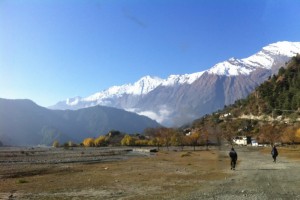
Just one of the amazing views out of the front window.
After 3.5 h we arrived in Ghasa, where we had to catch the bus to Tatopani. There were some misunderstandings regarding the purchase of the tickets, so we would have to wait 2 h for the next one to leave.
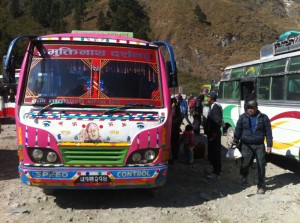
Nepalese really have a different view on car/bus design. Lovely.
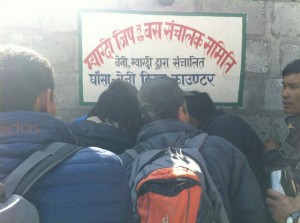
Somewhere there must be the hole where bus tickets can be purchased.
Nobody was amused by that so we went for walking the 15 km to Tatopani. After two thirds of the way Wing got the genius idea to get out the bottle of apple brandy, he had bought in Marpha to the great delight of Pablo. When we arrived in Tatopani all of us had some kind of buzz and the noise level increased significantly.
After dropping the bags and getting another bottle of rum we headed of to the hot spring. Of course I didn’t brought a swim suit, so being in a pool in underwear with mainly Nepalese I felt very naked. The hot water and the warm rum (Pablo hid it in the water, since they didn’t likes people drinking stuff from outside) created a party atmosphere and finished off our Chinese-American friend (his genes let him down) collapsing on his bed at 7 pm.
14. Day: Tatopani – Chitre
So it was finally the day of saying good bye to Wing and Yan, who where heading off to Pokhara.
Our diminishing group was heading off in the grey light off a cloudy morning. For the next 6 hours the path lead constant up hill over slippery stones, through the tropical woods and tiny mountain villages. For once we were more sweating then freezing. However, when we arrived in Chitre it was about to get dark and the cold returned.
15. Day: Chitre – Birethanti
The view from my sleeping bag this morning made a clear statement. The days of sunshine were over. Surrounded by clouds blocking our views we started ascending the last 500 m of the Annapurna Circuit accompanied by dozens of donkey and kids going to school in the village that lay behind us.
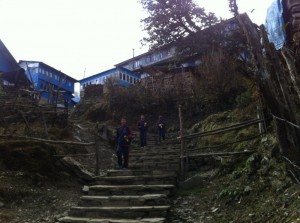
Really all the houses in Ghorepani are coloured in blue.
An hour later we arrived in Gorephani. From here people ascend to Pun hill that is supposed to have a gorgeous view, but not today as everybody told us. So we skipped the extra exercise and started to descend the 1800 m directly.
The descend of a seemingly endless
stairs (my calfs were killing me the next day) led through the well known green jungle and countless rice paddies with their ever hard working people. However, the atmosphere in the track changed from minute to minute by many asian trekker walking in front and behind us making this the most crowed part of the whole circuit.
After 6 hours constant downhill walking, stumbling and sliding we arrived very tired in Birethanti collapsing in the first lodge of the village.
The free WiFi in this place finally made my day with a email from Germany letting me know about the acceptance of a long fighted for paper. So we ended this day enjoying a cold beer together with the JayJays that also arrived here today.
16. Day: Birethanti – Pokhara
So it were only another 45 min walking time. We arrived we a pretty civilized road to Naypol, that supposedly has a bus station where busses going to Pokhara stop. When we arrived at the paved road we found a few shops but no clear sign of a bus stop. Anyway there was a bus standing around and we just ask for good luck.
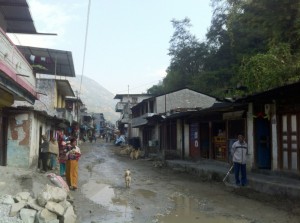
Back to urban life in Naya Pol.
It turned out to be a great deal. We were the only passengers, the ride was quite and uninterrupted and for 200 Rs the buys driver dropped us off at run main tourist hub in Pokhara.





